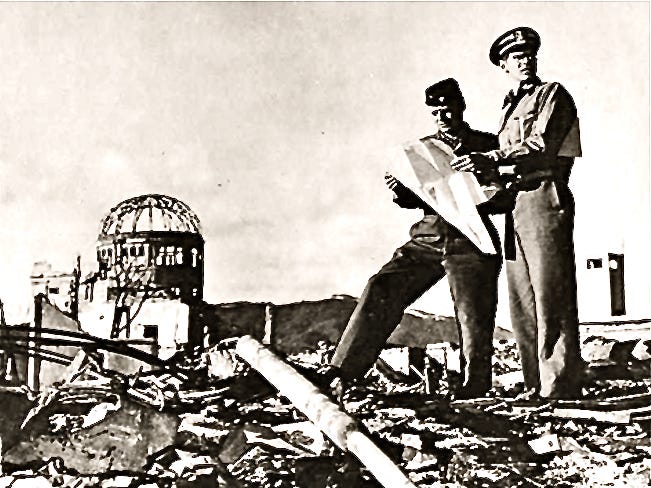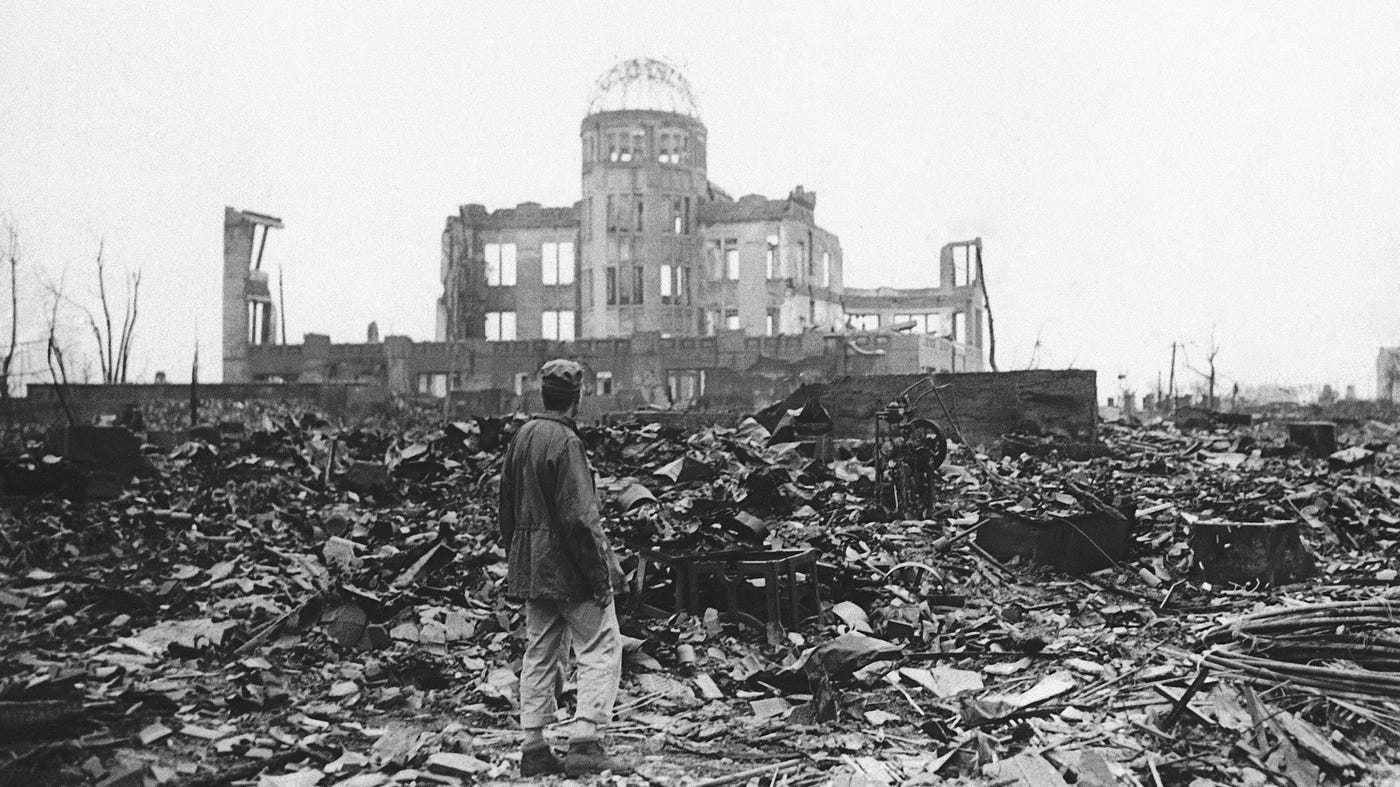Reprinted with permission from Greg Mitchell’s newsletter Oppenheimer: From Hiroshima to Hollywood.

Seventy-eight years ago this week, the first American troops landed at Yokohama, near Tokyo, with fifteen thousand pouring in within a few days, under the direction of Gen. Douglas MacArthur. Also arriving were forward elements of the U.S. Strategic Bombing Survey, which had been organized by the Army the previous November to study the effects of the air campaign against Germany and now shifted its sights to Japan.
The Japanese formally surrendered on the battleship Missouri on September 2. At this point, the American public knew little about conditions in the atomic cities, which are far from Tokyo, beyond Japanese assertions that a mysterious and deadly affliction was destroying many of those who survived the initial blasts (claims that were taken to be propaganda by Gen. Leslie Groves, among others, as we saw yesterday). No Westerners had arrived in Hiroshima and Nagasaki, few photographs circulated. The first Americans did not reach Hiroshima until September 3. They were beaten there by the Australian journalist Wilfred Burchett, who had already filed a story for the London Daily Express describing people dying from an “atomic plague.” The first American to reach Nagasaki, George Weller, found that all of his dispatches were spiked by General MacArthur’s office in Tokyo.
On September 8, General Thomas F. Ferrell arrived in Hiroshima with a radiologist and two physicists from Los Alamos, ordered to return to Tokyo the following day with preliminary findings. There was some urgency. It was one thing if the Japanese were dying of radiation disease; there was nothing we could do about that. But sending in American soldiers if it was unsafe was another matter. Three days later, Farrell announced that “no poison gases were released” in Hiroshima. Vegetation was already growing there.
The first large group of U.S. soldiers arrived in Nagasaki around September 23, and in Hiroshima two weeks later. They were part of a force of 240,000 that occupied the islands of Honshu (where Hiroshima is located) and Kyushu (Nagasaki). Many more landed in Nagasaki, partly because its harbor was not mined. Marines from the 2nd Division, with three regimental combat teams, took Nagasaki while the U.S. Army’s 24th and 41st divisions seized Hiroshima. The U.S. Navy transported Marines and evacuated POWs, but its role ashore beyond medical services was limited.
Most of the troops in Hiroshima were based in camps on the edge of the city, but a larger number did set up camps inside Nagasaki. Because of the alleged absence of residual radiation, no one was urged to take precautions. Some bunked down in buildings close to ground zero, even slept on the earth and engaged in cleanup operations, including disposing bodies, without protective gear. Few if any wore radiation detection badges, which also worked erratically.
“We walked into Nagasaki unprepared…. Really, we were ignorant about what the hell the bomb was,” one soldier would recall. Another vet said: “Hell, we drank the water, we breathed the air, and we lived in the rubble. We did our duty.”
A marine named Sam Scione, who had survived battles on Guadacanal, Tarawa and Okinawa, now arrived in Nagasaki, sleeping first in a burned out factory, then a schoolhouse. “We never learned anything about radiation or the effects it might have on us,” he later said. “We went to ground zero many times and were never instructed not to go there.” A year later, on his return to the U.S., his hair began to fall out and his body was covered in sores. He suffered a string of ailments – he was far from alone – but never was awarded service-related disability status.

The occupying force in Nagasaki grew to more than twenty-seven thousand as the Hiroshima regiments topped forty thousand. Included were many military doctors and nurses. Some stayed for months. The U.S. Strategic Bomb Survey sent a small group of photographers to take black and white photos of blast effects. By all accounts the Americans were charmed by the Japanese, and profoundly affected by what they witnessed.
“In the back of our minds, every one of us wondered: What is this atomic bomb?” a Nagasaki veteran later testified. “You had to be there to rea1ize what it did.” After describing the horrors, he added: “We did not drop those two [bombs] on military installations. We dropped them on women and children … I think that is something this country is going to have to live with for eternity.”
Mark Hatfield, a young naval officer in 1945 and later a longtime U.S. senator (known for his opposition to the Vietnam war), would reflect on his “searing remembrances of those days” in Hiroshima when a “shock to my conscience registered permanently within me.” Much of his legislative and personal philosophy was “shaped by the experience of walking the streets of your city,” he wrote to the mayor of Hiroshima in 1980, adding that he was “deeply committed to doing whatever I can to bring about the abolition of nuclear weapons.”
The biologist Jacob Bronowski revealed in 1964 that his classic study Science and Human Values was born at the moment he arrived in Nagasaki in November 1945 with a British military mission sent to study the effects of the bomb. Arriving by jeep after dark he found a landscape as desolate as the craters of the moon. That moment, he wrote, “is present to me as I write, as vividly as when I lived it.” It was “a universal moment … civilization face to face with its own implications.” The power of science to produce good or evil had long troubled other societies. “Nothing happened in 1945,” he observed, “except that we changed the scale of our indifference to man …. “
When Bronowski returned from Japan he tried to persuade officials in the British government and at the United Nations that Nagasaki should be preserved exactly as it was. He wanted all future conferences on crucial international issues “to be held in that ashy, clinical sea of rubble ….. only in this forbidding context could statesmen make realistic judgments of the problems which they handle on our behalf.” His colleagues showed little interest, however. They pointed out delegates “would be uncomfortable in Nagasaki,” according to Bronowski.
Just published: an expanded edition of my book Atomic Cover-up, now with several thousand words of mine re: the movie and the man Oppenheimer. And it’s on sale this week as an ebook for just $3.99 ($12.95 for the paperback).
Note: If you missed this comment by David Chambers on my post this week about Oppenheimer signing off on MGM movie about The Bomb while Einstein resisted. The grandfather, of course, was Whittaker Chambers:
My grandfather wrote that [Einstein] cover story for TIME:
• cover: https://content.time.com/time/covers/0,16641,19460701,00.html
• story: https://content.time.com/time/subscriber/printout/0,8816,803775,00.html
In the piece, my grandfather himself described the bomb as “the biggest boost humanity has yet been given toward terminating its brief history of misery and grandeur.” He also stated, “If the atom bomb blasted the last popular skepticism about Einstein’s genius it also blasted man’s complacent pride in the power of unaided intellect. At the very moment that it was finally mastered, matter was most elusive and most menacing.”
Thanks for reading Oppenheimer: From Hiroshima to Hollywood! Subscribe for free to receive new posts and support my work.
Greg Mitchell is the author of a dozen books, including “Hiroshima in America,” and the recent award-winning The Beginning or the End: How Hollywood – and America – Learned to Stop Worrying and Love the Bomb, and has directed three documentary films since 2021, including two for PBS (plus award-winning “Atomic Cover-up”). He has written widely about the atomic bomb and atomic bombings, and their aftermath, for over forty years. He writes often at Oppenheimer: From Hiroshima to Hollywood.




Nope, even back then there was a disregard for the health and well being of regular, everyday human beings by our “elite”, even American ones.
There were Americans facing radiation at Hiroshima and Nagasaki. That is of course neither discussed in history books nor history classes. The Government thought it was worth it despite that.
The US used chemical weapons in SE Asia during the Vietnam War and there could have been Americans infected by those WMD’s. The Media won’t talk about either of those things but talks about Iraq using WMD’s against its people and lies about Syria using them to justify its war there,